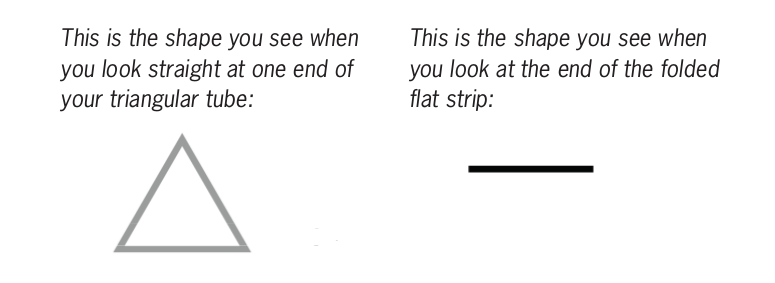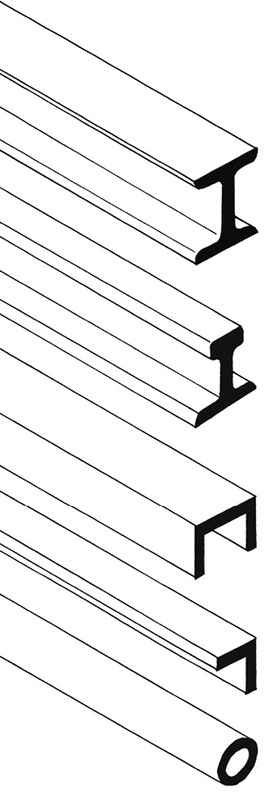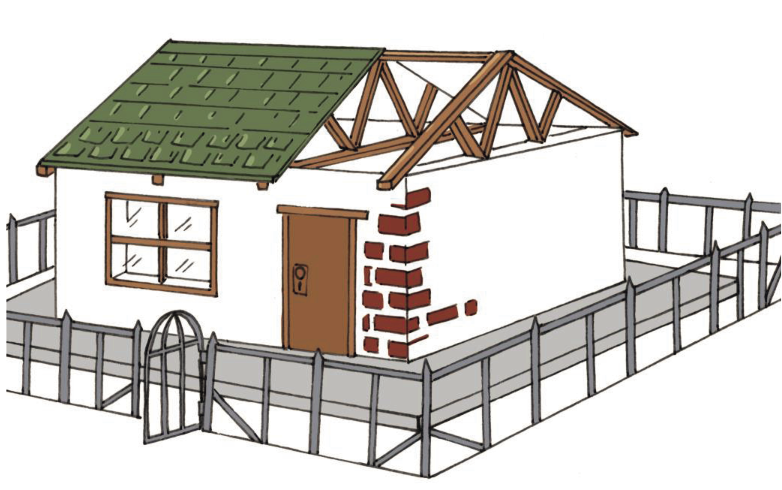Structures,forces and materials
In this chapter, you will learn about the forces that act on structures and can break them. You will see how structures and parts of structures can be strengthened. You will also learn about different materials that are used in structures, and how materials differ from each other.

Figure 1: This bridge cannot withstand the forces acting on it.

Figure 2: If the house is not strong enough, the wind may break it apart.

Figure 3: Roof sheets come in different shapes
Forces act in different places
Identify and analyse forces
The weight of the boy in Figure 4 presses down on the chair as the arrow shows.
When one object pushes against another object, we say that a force is exerted on the object. In this case, you can say that the boy exerts a downward force on the chair, or that there is a downward load on the chair.
-
In each of the pictures on this page and the next, make an arrow to show how the load acts on the structure.

Figure 4: The boy sits still on the chair.

Figure 5: A man walking on a roof.

Figure 6: A solar heating system on a roof.
-
-
Is the load on the roof in Figure 5 always in the same place? Why do you say so?
-
Is the load on the roof in Figure 6 always in the same place? Why do you say so?
-
Are the loads on the bridge in Figure 7 always in the same place? Why do you say so?
-

Figure 7: Vehicle passing over a bridge.
As long as a person sits still on a chair, the force on the chair remains in the same place. This is called a stationary or a static force.
-
In the above picture, the truck and the car exert forces on the bridge. Can these forces also be called static? Explain why you say so.
When a moving object exerts a force on another object, you can say that the force is dynamic.
-
In each of the following cases, state whether the force exerted on the table is static or dynamic. Explain why you say so in each case.
-
A pot of flowers standing on the table.
-
A cat walking on the table.
-
A boy rolling a soccer ball over the table.
-
A man scrubbing the table.
-
-
What is the difference between the loads exerted on the two tables below?

Figure 8: Different ways to put pots on a table.
Look at the different ways in which the two trucks below are loaded. On the one truck, the drums exert force everywhere on the cargo deck of the truck. On the other truck, the load is just one big drum. The single drum exerts force on a small part of the cargo deck.

Figure 9: Different kinds of load on two trucks.
A load that exerts an equal force over the whole structure that supports it, is called an even load. A load that mainly exerts a force on one part of the structure that supports it, is called an uneven load.
-
Think of a house with a zinc roof and the forces that the sheets exert on the roof structure.
-
Is the load even or uneven? Why do you say so?
-
Is the load static or dynamic? Why do you say so?
-
-
Think of people climbing up and down wooden steps.
-
Is the load even or uneven? Why do you say so?
-
Is the load static or dynamic? Why do you say so?
-
-
You have to design two wooden tables, and you are requested to use as little wood as possible. For the one table, the design brief states that the load on the table will always be static and even. The design brief for the other table states that it has to carry the same weight as the first table, but the load will sometimes be dynamic and uneven. Describe how your designs for the two tables will differ, and explain why.
Forces act in different ways
Forces can act in the following ways on structures or parts of structures:
- tension,
- torsion,
- compression,
- shear, and
- bending.
The different pieces of a frame structure are called sections, elements or members of the structure.

Figure 10: A frame structure made of planks.
Forces can push, pull and twist
Make six paper tubes by rolling sheets of used writing paper. Use glue or tape to prevent the tubes from unrolling.

Figure 11
-
Put your hands on both ends of a tube and push them towards each other. When you do this, you exert compression forces on the tube.
-
Grab a tube at both ends and try to pull it apart. When you do this, you exert tensile forces on the tube. You put the tube under tension.
-
Put the ends of the tube on two books and press downwards on the middle of the tube. What happens, and what kind of force did you apply to the tube?
-
Grab a tube at both ends and twist it as shown in this picture. When you do this, you apply torsion.

Figure 12
-
Join two tubes by putting a match or small stick through them as shown below.

Figure 13
When you try to pull the two paper tubes apart now, you will apply shear forces to the stick.
Find strength in shape
-

Figure 14

Figure 15
Fold it a third time, so that you have a flat strip that is eight layers thick.
Make two more folded strips like this.

Figure 16
-
Put the folded strip at the edge of your desk as shown below. Hold it down on the desk with one hand and press down lightly on the outer part of the strip to bend it downwards.

Figure 17
-
Now fold your paper strip half-open again, and fold it in a new way so that you get a triangular tube as shown below.
First fold like this: Then fold like this:

Figure 18

Figure 19

Figure 20
-
-
Put the triangular tube at the edge of your desk as you did with the flat strip in question 2. Hold it down on the desk with one hand and press down lightly on the outer part to bend it downwards.
-
What was easier to bend, the flat strip or the triangular tube?

Figure 21
The shape that you see when you look straight at one end of part of a structure is called the cross-section or profile.
-
-
Make free-hand sketches of the cross-sections of a round tube, a square tube and a triangular tube, in the space below.

-
Open your triangular tube and fold it again to have a T-profile as shown on the right.

Figure 23

Figure 22
-
Let your T-shaped section stand upright on your desk as shown here and press downwards at the top. Do not bend it now.
Take one of the flat folded sections you made in question 1. Hold it upright and press downwards at the top like you did for your strip with the T-cross section.
Which strip is stronger when you press down on its end, the flat section or the T-shaped section? Explain why.
A T-shaped section resists compression better than a flat section that has the same length and is made of the same amount of material (paper in this case).

Figure 24
-
Compare the resistance to compression of T-shaped, square-shaped and round sections, each made from one sheet of A4 paper. Explain your answers.

Figure 25: Metal cross-sections Metal sections that are used to build frame structures are made in a variety of profiles. Some popular profiles are shown below.
H-profile. This profile is often used as upright supports or columns, for example in buildings. It resists compression very well, and it does not bend easily.
I-profile. This profile is used for railway tracks. The broad base provides stability.
U-profile. This is lighter than the H-profile. It is often used to provide horizontal support, for example in shelves. The chassis of a truck is normally made with U-beams.
This profile is often called angle-iron, even if it is made of metal. It has higher bending strength than flat strips. It is light and is often used for cross-bracing in pylons, towers and other structures.
Tube-profile. This is the best profile for resisting torsion.

Using internal cross-bracing to resist twisting
Imagine that you made a frame structure with straight pieces of wood.

Figure 26
Now imagine that you twist this frame structure like the person in the photograph is twisting the towel.

Figure 27
The frame structure could end up looking like this:

Figure 28
To prevent the structure from getting twisted like this, you could add more elements as shown here.

Figure 29
This is called internal cross-bracing.
Different materials for different purposes
How materials can differ from each other
-
What bends more easily: your pencil or a sheet of paper?
-
Put a sheet of paper flat on your desk. Pick it up with both hands and bend it. Now put it back on the desk. Is it flat again?
Material that bends easily, but returns to its original shape when you let go of it, is called flexible material. Material that is not flexible is called stiff material. -
Is wet clay flexible or stiff?
-
Is the leg of a chair flexible or stiff?
-
Is a piece of wire flexible or stiff?
-
Is your shoe flexible or stiff?
-
-
Press your finger against your desk. Now press your finger against your arm.What was different when you pressed your finger against your desk from when you pressed your finger against your arm?
-
When you press your finger against a bag of sand, will it be the same as against your desk or arm?
Bricks are made by baking clay until it is hard.
Some materials are hard, and some materials are soft.
-
-
Think of a brick and a piece of foam plastic that is the same size as the brick (like the foam used in mattresses). Which is easier to pick up?
-
How many bricks do you think you can carry easily if you put them in a box to carry on your shoulder?
-
How many pieces of foam plastic of the same size do you think you can carry easily if you put them in a box to carry on your shoulder?
A brick is much heavier than a piece of foam plastic of the same size.
One difference between baked clay and foam plastic is that when you take pieces of equal size, the baked clay will be heavier than the foam plastic. It will require more effort to pick it up or to carry it.
The difference between baked clay and foam plastic can be described as follows: Baked clay has a higher density than the foam plastic.
-
-
-
What material has the highest density: wood or rock?
-
What material has the highest density: glass or plastic?
Pieces of metal that lie around outside sometimes look brown. This is called rust or corrosion. Rust is formed by chemical reactions between the metal and oxygen in the air or water. Wood and glass do not corrode. Rock that contains iron does corrode. When you walk in the veld, you can sometimes see pieces of rock that have the same shade of brown.
Corroded rock can have different colours, like those in the coloured strip at the bottom of this page. In the past, colouring for paint was obtained from corroded rock.
-
-
Iron is used in the construction of towers, roofs, cars and trucks and sometimes even furniture. What can you do to prevent iron from corroding?

More about metals
There are many different metals, such as copper, iron, aluminium, chrome, gold and platinum. Iron is cheaper than most other metals, because it is so plentiful. It is also easy to make iron into different shapes. Iron is normally mixed with a small amount of carbon to form "steel", which is much stronger than pure iron.
Unfortunately, iron corrodes or rusts easily, while other metals do not corrode as easily, if at all. For this reason, iron is often mixed with other metals, for example chrome, to make it resistant against rust. "Stainless steel" is steel that contains a large amount of chrome.
Materials in a house
A house is a good example of a structure made of many different materials. To build a house like the one below, you can use bricks, concrete, wood and steel.

-
Different parts of the house are listed in the left column of the table below. In the right column, fill in what material you think that part of the house is made of.
Part of the house
Material it is made of
The walls
The window frames
The door
The roof structure
The roof cover
The fence
The paving around the house
Builders choose bricks, concrete, wood and metal because each one is useful in different ways. You can say different materials have different properties.
Concrete is hard and it will not scratch easily, so builders use it on house floors. Concrete is also stiff, so it will not bend when we walk on it. Concrete is not damaged by water and it will not rust.
Bricks do not bend and do not rust, so they are used to build walls.
Wood is used in a house for doors, windows and roofs, because it is flexible. This means that when you slam a door, the wood bends a little but will not break.
Wood can be damaged by water, wind and the heat of the sun. To protect wood against damage and to make it last longer, it should be coated with varnish, oil or some other preservative material.
Steel is hard and strong. Steel is also flexible and it is not easy to crack with a hammer. Therefore steel is used in security gates. However, steel is damaged by water; this is called rusting or corrosion. To stop rusting, you have to cover steel with special paint.
-
Fill in which materials are used for the different parts of the house in the middle column. Then fill in the reasons why you think that material is used for that part of the house in the column on the right.
Part of the house
Material
Reasons for choice of material
Walls
Window frames
Door
Roof structure
Roof cover
Fence
Paving around the house
-
Some houses have tile roofs, other houses have zinc roofs. What are the advantages and disadvantages of tile roofs?
Advantages of tile roofs
Disadvantages of tile roofs
-
What are the advantages and disadvantages of zinc roofs?
Advantages of coated iron roofs
Disadvantages of coated iron roofs
-
In the old days, wagon wheels were made of wood. Today we use rubber tyres. Why did we change from wood to rubber?
-
When builders put glass in a window frame, they push a soft sticky material called putty round the edge of the glass. The putty dries until it is hard and stops the glass from falling out. Peanut butter is also a soft sticky material and dries in the sun until it is hard. Why is it not a good idea to use peanut butter to fit glass in window frames?

Next week
Next week, you will start with your practical assessment task. You will make a plan to address a need in a community.



